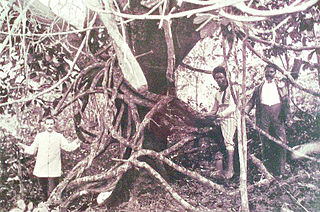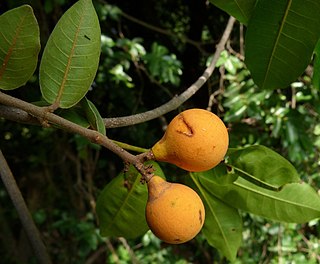
Apocynaceae is a family of flowering plants that includes trees, shrubs, herbs, stem succulents, and vines, commonly known as the dogbane family, because some taxa were used as dog poison. Members of the family are native to the European, Asian, African, Australian, and American tropics or subtropics, with some temperate members. The former family Asclepiadaceae is considered a subfamily of Apocynaceae and contains 348 genera. A list of Apocynaceae genera may be found here.

Berberis, commonly known as barberry, is a large genus of deciduous and evergreen shrubs from 1–5 m (3.3–16.4 ft) tall, found throughout temperate and subtropical regions of the world. Species diversity is greatest in South America and Asia; Europe, Africa and North America have native species as well. The best-known Berberis species is the European barberry, Berberis vulgaris, which is common in Europe, North Africa, the Middle East, and central Asia, and has been widely introduced in North America. Many of the species have spines on the shoots and all along the margins of the leaves.
Androstachys johnsonii, the Lebombo ironwood, is a medium-sized Afrotropical tree species, and the sole member of the genus Androstachys in the Picrodendraceae. It is slow-growing, evergreen to deciduous, and dioecious, with flowers that are wind-pollinated. It is native to southeastern Africa and Madagascar, where it generally occurs gregariously on rocky hillsides, particularly in hot and dry situations. It produces a hard, durable wood which is of economic interest. Its specific name commemorates W. H. Johnson, a 19th-century Director of Agriculture in Mozambique. Four related species which are native to Madagascar, are usually placed in genus Stachyandra.

Persoonia longifolia, commonly known as snottygobble, is a species of flowering plant in the family Proteaceae and is endemic to the southwest of Western Australia. It is a shrub or small tree characterised by its weeping foliage, yellow flowers and distinctive flaky bark.

Annona senegalensis, commonly known as African custard-apple, wild custard apple, wild soursop, sunkungo, and dorgot is a species of flowering plant in the custard apple family, Annonaceae. The specific epithet, senegalensis, translates to mean "of Senegal", the country where the type specimen was collected.

Hakea denticulata, commonly known as stinking Roger is a shrub tree endemic southern Western Australia. One of the many species of Australian plant described by the botanist Robert Brown. A compact shrub 1–2 m (3–7 ft) high and wide with red flowers in the spring with an unpleasant odour.

Persoonia juniperina, commonly known as prickly geebung, is a species of flowering plant in the family Proteaceae and is endemic to south-eastern Australia. It is a small erect to low-lying shrub with smooth bark, hairy new branches, linear leaves, yellow flowers borne singly or in groups of up to forty in leaf axils, and yellowish green to purplish fruit.

Persoonia silvatica, commonly known as the forest geebung, is a plant in the family Proteaceae and is endemic to south-eastern Australia. It is a shrub or tree with more or less lance-shaped leaves and small groups of yellow flowers with white centres. It grows mainly in forest near the border between New South Wales and Victoria.
Landolphia kirkii is a species of liana from the family Apocynaceae that can be found in Democratic Republic of the Congo, Malawi, Mozambique, Tanzania, Zambia, Zimbabwe, and in the KwaZulu-Natal province of South Africa.

Persoonia isophylla is a plant in the family Proteaceae and is endemic to New South Wales. It is an erect or spreading shrub with soft, pine-like leaves and groups of cylindrical yellow flowers. It is similar to P. pinifolia but the flowers of that species have small leaves at their base, where the flowers of P. isophylla have full-sized leaves at their base. The two species sometimes grow together but hybrids between them are rare.

Landolphia is a genus of flowering plants in the family Apocynaceae first described as a genus in 1806. They take the form of vines that scramble over host trees. Landolphia is native to tropical Africa.

Persoonia rufa is a species of flowering plant in the family Proteaceae and is endemic to the a restricted area of New South Wales. It is an erect to spreading shrub with hairy young branchlets, elliptic leaves, and yellow flowers borne in groups of up to twelve on a rachis up to 110 mm (4.3 in), each flower with a leaf at its base.

Landolphia owariensis is a species of liana from the family Apocynaceae found in tropical Africa. Latex can be extracted from this plant for the manufacture of natural rubber. Other names for this vine are eta, the white rubber vine and the Congo rubber plant. Congo rubber was a commercial rubber exported from the Congo Free State starting in 1890, most notable for its forced harvesting under conditions of great human suffering, in the Congo Free State, detailed in the 1904 Casement Report. From 1885 to 1908, millions died as a result of murder, deprivation, and disease, with population falling by millions in this period; some writers estimate this loss to be as high as 10 million people.

Mimetes saxatilis or limestone pagoda is an evergreen, upright, rarely branching shrub of 1–2¼ m high, assigned to the family Proteaceae. The approximately oval leaves are 3½–5 cm (1.4–2.0 in) long and 1½–3 cm (0.6–1.2 in) wide with a blunt, thickened, reddish tip or with three crowded teeth. It has cylinder-shaped inflorescences topped by a crest of green leaves, further consisting of heads with 12-22 individual bright yellow flowers, each in the axil of a flat, green leaf. It is an endemic species that is restricted to limestone outcrops in the Agulhas plains in the very south of the Western Cape province of South Africa. It is considered an endangered species. Flowering may occur between July and December, but is unreliable in its timing, dependent on sufficient moisture availability.

Landolphia heudelotii is a climbing shrub or liana that is within the Apocynaceae family, it occurs in the Guinea and Sudan savannahs of West Africa and cultivated for its rubber and edible fruit.
Landolphi mannii is a liana within the Apocynaceae family. Its fruit, with significant lipid and iron content is consumed by locals and it is also a part of the diet the Mandrillus sphinx.
Landolphia angustisepala is a species within the Apocynaceae family. It occurs in Gabon and the Democratic Republic of the Congo.
Landolphia buchananii is a liana within the Apocynaceae family. It is sometimes called Nandi rubber in English and known locally as Mugu among Kikuyus. Occurs in savannahs and montane forests in East Africa and Southeastern Nigeria.

Gardenia erubescens is a shrub or small tree species with edible fruits that occurs in the Guinea and Sudan savannah vegetation of West and Central Africa. It is within the Rubiaceae family.
Boscia salicifolia is a deciduous tree with narrowly ovate to linear leaves that grows up to 12 meters in height, it is within the Capparaceae family.













